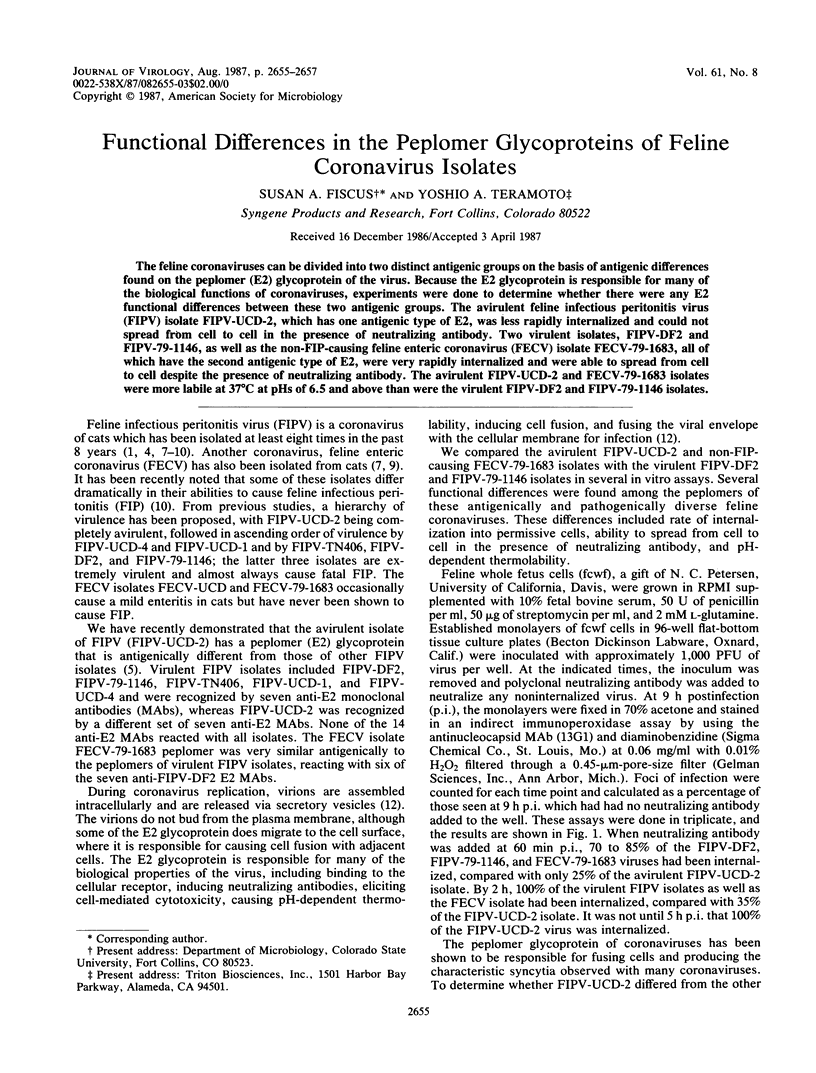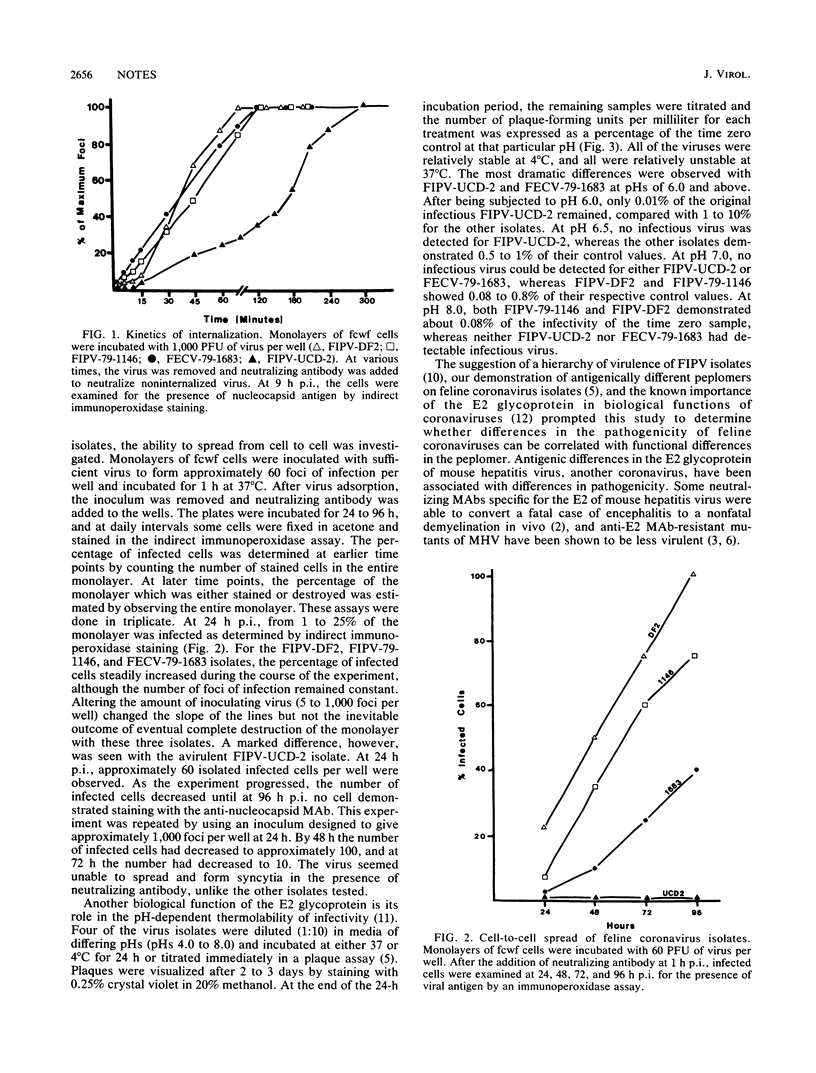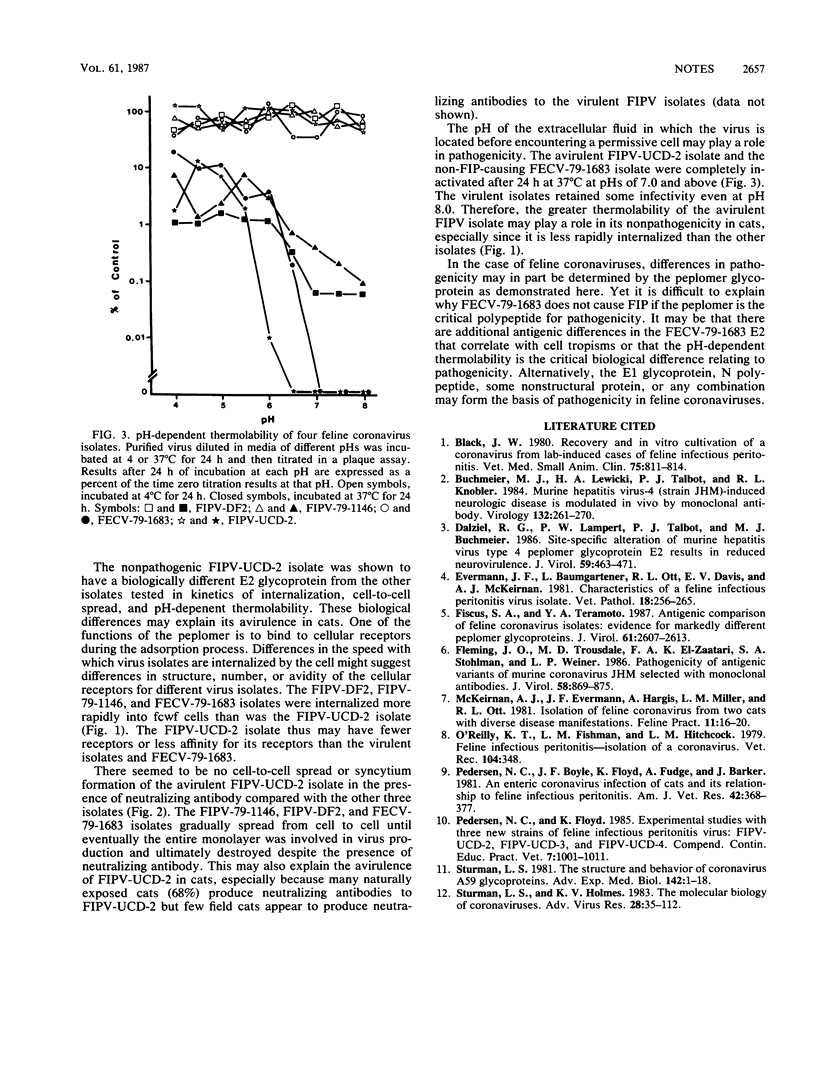Abstract
The feline coronaviruses can be divided into two distinct antigenic groups on the basis of antigenic differences found on the peplomer (E2) glycoprotein of the virus. Because the E2 glycoprotein is responsible for many of the biological functions of coronaviruses, experiments were done to determine whether there were any E2 functional differences between these two antigenic groups. The avirulent feline infectious peritonitis virus (FIPV) isolate FIPV-UCD-2, which has one antigenic type of E2, was less rapidly internalized and could not spread from cell to cell in the presence of neutralizing antibody. Two virulent isolates, FIPV-DF2 and FIPV-79-1146, as well as the non-FIP-causing feline enteric coronavirus (FECV) isolate FECV-79-1683, all of which have the second antigenic type of E2, were very rapidly internalized and were able to spread from cell to cell despite the presence of neutralizing antibody. The avirulent FIPV-UCD-2 and FECV-79-1683 isolates were more labile at 37 degrees C at pHs of 6.5 and above than were the virulent FIPV-DF2 and FIPV-79-1146 isolates.
Full text
PDF


Selected References
These references are in PubMed. This may not be the complete list of references from this article.
- Black J. W. Recovery and in vitro cultivation of a coronavirus from laboratory-induced cases of feline infectious peritonitis (FIP). Vet Med Small Anim Clin. 1980 May;75(5):811–814. [PubMed] [Google Scholar]
- Buchmeier M. J., Lewicki H. A., Talbot P. J., Knobler R. L. Murine hepatitis virus-4 (strain JHM)-induced neurologic disease is modulated in vivo by monoclonal antibody. Virology. 1984 Jan 30;132(2):261–270. doi: 10.1016/0042-6822(84)90033-3. [DOI] [PMC free article] [PubMed] [Google Scholar]
- Dalziel R. G., Lampert P. W., Talbot P. J., Buchmeier M. J. Site-specific alteration of murine hepatitis virus type 4 peplomer glycoprotein E2 results in reduced neurovirulence. J Virol. 1986 Aug;59(2):463–471. doi: 10.1128/jvi.59.2.463-471.1986. [DOI] [PMC free article] [PubMed] [Google Scholar]
- Evermann J. F., Baumgartener L., Ott R. L., Davis E. V., McKeirnan A. J. Characterization of a feline infectious peritonitis virus isolate. Vet Pathol. 1981 Mar;18(2):256–265. doi: 10.1177/030098588101800214. [DOI] [PubMed] [Google Scholar]
- Fiscus S. A., Teramoto Y. A. Antigenic comparison of feline coronavirus isolates: evidence for markedly different peplomer glycoproteins. J Virol. 1987 Aug;61(8):2607–2613. doi: 10.1128/jvi.61.8.2607-2613.1987. [DOI] [PMC free article] [PubMed] [Google Scholar]
- Fleming J. O., Trousdale M. D., el-Zaatari F. A., Stohlman S. A., Weiner L. P. Pathogenicity of antigenic variants of murine coronavirus JHM selected with monoclonal antibodies. J Virol. 1986 Jun;58(3):869–875. doi: 10.1128/jvi.58.3.869-875.1986. [DOI] [PMC free article] [PubMed] [Google Scholar]
- O'Reilly K. J., Fishman B., Hitchcock L. M. Feline infectious peritonitis: isolation of a coronavirus. Vet Rec. 1979 Apr 14;104(15):348–348. doi: 10.1136/vr.104.15.348. [DOI] [PubMed] [Google Scholar]
- Pedersen N. C., Boyle J. F., Floyd K., Fudge A., Barker J. An enteric coronavirus infection of cats and its relationship to feline infectious peritonitis. Am J Vet Res. 1981 Mar;42(3):368–377. [PubMed] [Google Scholar]
- Sturman L. S., Holmes K. V. The molecular biology of coronaviruses. Adv Virus Res. 1983;28:35–112. doi: 10.1016/S0065-3527(08)60721-6. [DOI] [PMC free article] [PubMed] [Google Scholar]
- Sturman L. S. The structure and behavior of coronavirus A59 glycoproteins. Adv Exp Med Biol. 1981;142:1–17. doi: 10.1007/978-1-4757-0456-3_1. [DOI] [PubMed] [Google Scholar]


